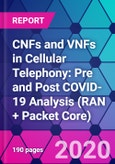COVID-19 and its associated measures have been a mixed bag for telcos. On one hand, telcos and NF vendors will get adversely affected by the most unprecedented global recession witnessed in close to a century; the crisis presents several opportunities for telcos. Work-from-home (WFH) will lead to a demand for quality telecommunication infrastructure at the retail customer level – something that 5G networks are best placed to offer. This is just one of the many examples in which telecom and 5G will contribute to the changing world. The publisher therefore forecasts that the drop in market size for VNFs and CNFs will be moderate when compared to the setback faced by the global economy at large.
CNFs will outpace VNFs comprehensively during 2020-2025. While the shock of 2020 will curb spending for about 18 months, the industry will quickly bounce back powered by the growing 5G installations. 5G can be considered to be the most potent brand ambassador for CNFs due to its bent on cloud-native technologies. Unsurprisingly, CNFs will come to occupy close to 18 per cent of the overall Core and RAN market (virtualized and containerized); an unthinkable prospect a few years ago.
Global Market for VNFs and CNFs in Core and RAN; 2019-2025
Please note: This report is a combination of the 'CNFs and VNFs in Cellular Telephony Packet Core: Pre and Post COVID-19 Analysis' and 'CNFs and VNFs in Cellular Telephony RAN: Pre and Post COVID-19 Analysis' reports from the publisher, available separately.
VNFs and CNFs in Core and RAN Functions; Market Share 2020-2025 (%)
Table of Contents
Samples

LOADING...
Companies Mentioned
- Affirmed Networks
- Airtel
- AT&T
- Athonet
- Baicells
- BT
- China Mobile
- China Telecom
- China Unicom
- Cirrus Core Networks (CCN)
- Cisco Systems
- Dell EMC
- Deutsche Telekom
- Enea
- Ericsson
- Etisalat
- Huawei
- Intel
- Jio
- KDDI
- KT
- LG Uplus
- Lifecell Ukraine
- M1 Singapore
- Mavenir
- Metaswitch
- NEC/Netcracker
- Nokia
- NTT DoCoMo
- Ooredoo
- Optus (Singtel Optus)
- Oracle
- Orange
- Quortus
- Radisys
- Rakuten
- Red Hat
- Saudi Telecom (STC)
- Singtel
- SK Telecom
- Softbank
- Sprint Corporation
- Swisscom
- T-Mobile
- Telefonica
- Telenor
- Telia
- Telkom Indonesia
- Telrad Networks
- Telstra
- TIM/Telecom Italia
- Turk Telecom
- Turkcell
- Veon VimpelCom
- Verizon
- VMware
- Vodafone
- WIND
- Wind River
- ZTE
Methodology

LOADING...










